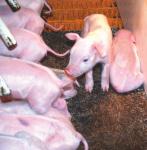LINNEUS, Mo. – The best way to wean calves from a fall-calving cow herd in April is to delay until July.
Delayed weaning gives an extra pound of gain per day, and weaning is easy when the cow begins to dry up in July and the calf is too big to nurse. Best of all, the calves earn an extra $100 per head by weaning time.
Researchers at the University of Missouri Forage Systems Research Center studied four weaning options for their fall-calving cows.
“Calves left with their mothers through the spring grazing season gained an average of 2.1 pounds per day in the three-year study,” said Rob Kallenbach, MU Extension forage specialist at the FSRC field day, Aug. 3.
“In comparison, calves weaned in April and grazed in an eight-paddock rotational grazing system gained only nine-tenths pound per day. This was the traditional stocker system.”
The researchers – Kallenbach, MU beef nutritionist Justin Sexten and center superintendent David Davis – found many advantages for the delayed-weaning option.
“In April, May and June there is more grass growing than the cow herd can eat,” Kallenbach said. “Keeping the fast-gaining calves with the herd, helps control grass in the paddocks.”
The MU study demonstrated that milk from the cows is a good supplement for grass that the calves are eating. Kallenbach explained that as long as a calf is not weaned, the esophageal bypass stays active. Milk nursed by the calf goes directly to the lower digestive tract, not into the rumen.
“Milk is the perfect bypass protein for calves,” Kallenbach said. “That helps account for added weight gain.”
Three other options in the MU study compared to July delayed weaning. One weaned in April but gave calves first choice in grazing paddocks, a leader-follower system. A second option took the leader-follower system and added supplemental feed to replace protein from missed milk.
Finally, calves were rotated through the grazing paddocks in a traditional stocker system, without grazing assistance from mother cows cleaning up the residue. In the stocker system, the calves were weaned, trucked to a sale barn for an overnight stay and then hauled back to the research farm. “We tried to replicate what happens to a lot of Missouri stocker calves,” Kallenbach said.
Fall calves weaned in July typically hit a yearly high in feeder-calf prices. The price declines to a seasonal low as spring calves are sent to market in the fall.
“Delayed weaning couldn’t be easier,” Kallenbach said. “It’s strictly low-stress. By July, the calves have about weaned themselves. And, the mother cows let them go.”
Some visitors on the tour wagon questioned what happens to a cow’s body condition score (BCS) when nursing a calf that long. What was the cow’s condition at calving time in September and at rebreeding in December?
“No problems,” Kallenbach said. “In the three years, the cow BCS at the end of July was right at 7, on a nine-point scale. We want cows in BCS 5 or better at calving and breeding.”
“Our cows carried a couple of extra body condition scores into winter,” Kallenbach said. In answer to a question, he added the re-breeding rate ranged from 89 percent to 93 percent in the three years.
However, he cautioned to not try delayed weaning with heifers that are still growing. The cows in the study were three-years old, and older.
Fall-calving herds are gaining popularity because of better calving weather in September and October. “Calving in February is a killer,” Kallenbach added.
Read more http://extension.missouri.edu/news/DisplayStory.aspx?N=854





